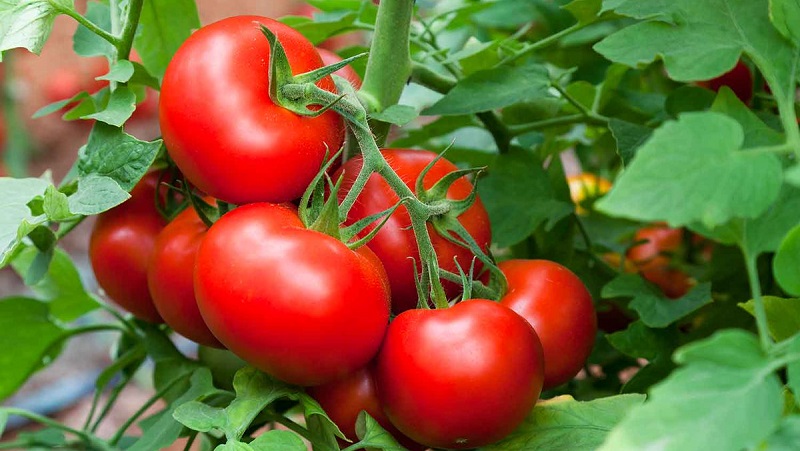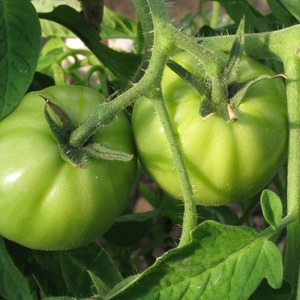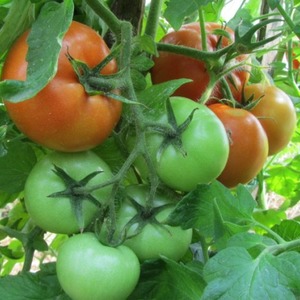How to grow the Maryina Roshcha tomato correctly: reviews, photos and the yield of an early-ripening hybrid
The dream of any gardener is a rich harvest combined with an excellent taste of the fruit. Therefore, gardeners often plant several crops in order to find among the many exactly the one that will satisfy them in all respects. The task of modern breeding is to combine in one culture all the wishes of gardeners, namely: a high rate of fruiting, resistance to diseases and excellent taste.
Tomato Maryina Roshcha is one of such developments from the Uralsky Dachnik firm. All the gardener's dreams come true in this hybrid. Numerous vegetables surprise even the most sophisticated grower with their excellent taste and yield.
The content of the article
Feature and Description
The f1 hybrid is obtained by crossing two varieties. One indicates belonging to the first generation. As a rule, the main differences between a hybrid and a pure variety are early maturity and high resistance to diseases.
Reference. Translated from Latin hybrida means "cross", and f hides the full name filli, which means "child." It follows that f1 is a child of the first generation.
Distinctive features
The type is indeterminate with a main stem height of 1.5-1.7 m. The stem is powerful with a large number of fruiting branches. Each brush sets 8-9 fruits. The leaves are medium, dark green.
The ripening period is early, from the moment the seeds are grown to full maturation, 85-100 days pass. The hybrid is intended for cultivation in greenhouse conditions in all regions.
Productivity is high, 5 kg of fruits are harvested from 1 seedling when plants are formed in 1 or 2 stems. A large number of lateral shoots requires regular pinching throughout the growing season.
The variety has good resistance to many diseases of the nightshade family.
When breeding indeterminate plants, do not forget about pinching the crown and installing garter supports.

Fruit characteristics
The average weight of one fruit is 160 g, the shape is round, slightly flattened on top. The color is bright red, the taste is sweet with a barely perceptible sourness. The pulp is juicy, dense. The rind is thin but not soft.
The purpose of ripe vegetables is universal, they are used to prepare various fresh dishes, preserves, pickles and marinades. Also, vegetables are allowed to be processed into tomato products, getting delicious juices, pastes, sauces and adjika.
Ripe vegetables can withstand long-term transportation and storage. For these reasons, entrepreneurs are considering the variety commercially.
The photo shows tomatoes Maryina Roscha f1.
How to grow seedlings
Sowing seeds for seedlings begins at the twentieth of February. The culture belongs to hybrid, so it will not be possible to prepare seeds on your own. You have to buy them every time.
Reference. Hybrid seed is more expensive than pure varietal crops. This is because it takes more time and resources to breed hybrids.
Seed preparation
Purchased seed they do not need special processing, since the manufacturer takes care of everything himself. But to improve germination, the seeds are soaked in a growth stimulator for 10-11 hours. As stimulants use specialized drugs ("Zircon", "Kornevin") or folk remedies (aloe juice and melt water).
Reference. When using folk remedies as stimulants, the percentage of germination is not lower than when using special preparations.
Choosing a container and preparing the soil
A common wooden box or individual containers serve as a landing container. Plastic cups are most often chosen from separate containers, since they are the cheapest. At the bottom of the containers, small drainage holes are made to drain excess moisture into them. Waterlogged soil threatens the occurrence of black leg disease.
Reference. The black leg is especially dangerous in the seedling period, as it can destroy all seedlings.
The most convenient container for breeding seedlings is peat pots. When choosing these containers, further time and effort is minimized.
When planting in a common wooden box, a mandatory picking of seedlings is required, otherwise the root system will not receive proper development.
The soil is prepared from turf, peat and humus in equal amounts. For additional nutrition, add 1 tablespoon of superphosphate and wood ash. After thorough mixing of the components, the soil mixture is poured with a hot solution of potassium permanganate to destroy pathogenic spores. Decontaminated soil promotes healthy seedling growth.
The resulting soil is laid out in containers, filling them by two-thirds.
Sowing
The seeds are buried 1.5 cm at a distance of 2-3 cm from each other, sprinkled with earth on top, slightly compacted and watered with warm, settled water using a spray bottle.
Important! If the seeds are sown shallowly, they will germinate with the shell, which will slow down their further growth.
The seeded containers are covered with foil to create a greenhouse effect and left in a warm room at a temperature of 24 ° C until shoots appear.
Seedling care
 When seedlings appear, the film is removed and the containers are placed in a well-lit place on the windowsill. Daylight hours are provided for at least 13 hours, otherwise, with a lack of lighting, the seedlings stretch out and weaken.
When seedlings appear, the film is removed and the containers are placed in a well-lit place on the windowsill. Daylight hours are provided for at least 13 hours, otherwise, with a lack of lighting, the seedlings stretch out and weaken.
The hybrid tolerates the lack of lighting, but during the seedling period it is better not to abuse this feature.
Watered as the upper soil layer dries up with warm, settled water. Seedlings need constant wet feeding; complete drying of the soil should not be allowed. At the same time, you should not overmoisten the soil. This threatens with fungal diseases. After watering, the soil is shallowly loosened for better oxygen access.
When 2 true leaves appear, the seedlings dive, seating them in separate containers. The seedlings are deepened to the cotyledonous leaves. Before a dive, the ground is watered abundantly with warm water in order to transplant it along with an earthen clod. The picking contributes to the increased build-up of the side roots.
2 weeks after the pick, the first top dressing is applied. Dissolve 1 tablespoon of nitrophoska in 1 bucket of water. Top dressing is applied along with watering.
2 weeks before planting, the seedlings begin to harden. Thanks to this procedure, the seedlings are more likely to take root in the ground and the transplant will not be stressful for it.
For hardening, the seedlings are taken outside in the daytime for 1 hour, gradually increasing the time spent outside to several hours. Young bushes are hardened at a daytime temperature of at least 16 ° C. After the stem acquires a light lilac color, the seedlings are ready for transplanting.
How to grow tomatoes
Since tomatoes are planted in a greenhouse, it should be prepared in 2 weeks. The soil is dug up and watered with warm water with manganese crystals so that it warms up better. Cold ground will slow down the growth of seedlings. The greenhouse is treated with Bordeaux liquid to kill fungal spores.
Landing
Tomatoes at Maryina Roshcha should be planted as soon as the soil warms up to 17 ° C.In pre-prepared holes 15 cm deep, a little wood ash is placed on the bottom, mixed with the ground and poured with warm water.
Planting pattern: 40 cm - distance between seedlings, 70 cm - between rows. For 1 sq. m place no more than 3 plants.
After transplantation, the wells are compacted and left to adapt to new conditions for 1 week.
Further care
Water the culture no more than 2 times a week with warm water. It is impossible to fill in the beds, as high humidity will provoke the development of fungal diseases. The greenhouse must be ventilated on a daily basis. The inflow of fresh air is a good prevention of diseases and pests.
After glaze the soil is loosened and hilled, thereby improving the air permeability of the soil. To keep the beds moist longer, they are mulched with straw.
It is necessary to feed the culture once every 10 days. As top dressing use a full range of minerals or organics. Fertilizers are used mainly containing phosphorus and calcium. If fed only with nitrogenous substances, the plants will gain green mass, and not form ovaries. From organics, an infusion of mullein is used in a ratio of 1:10. Mineral fertilizers alternate with organic fertilizers, providing the necessary nutrition throughout the season.
Important! All dressings are combined with watering.

Possible difficulties during the growing season
The bush is stepchild after the appearance of 8 leaves. Stepchildren are cut off every week, preventing them from reaching 5 cm. Otherwise, pinching will become a painful procedure for plants. To avoid the occurrence of infections, the cut sites are treated with a weak solution of manganese.
To increase productivity, the plants are formed into 1 or 2 stems. It is with this technique that the maximum indicator can be achieved.
Bushes are tied to a trellis, installing metal supports on different sides of the beds. A wire is stretched horizontally between the supports and the stem and fruit-bearing branches are fixed to it. Tomatoes are tied up regularly, as new branches develop.
To limit growth, pinch the crown. Without this procedure, the growth of the main stem will not stop, and unnecessary branches will take away the nutrients necessary for the formation of ovaries.
Diseases and pests
Judging by the characteristics and reviews, the Maryina Roshcha hybrid has high immunity, so you should not be afraid of fungal and viral infections. When carrying out preventive measures, the bushes will stand healthy all season. Prevention consists in observing the rules of crop rotation, moderate watering, loosening and daily ventilation of closed structures.
Of the pests for the culture, slugs are especially dangerous. Regular inspection of seedlings for pests will help prevent their spread and take the necessary measures in time. To combat them, the seedlings are regularly sprayed with nettle infusions and the stem is treated with soapy water. Experienced gardeners also know that slugs are attracted by the beer scent and set up traps by pouring some beer into them.
Nuances when breeding greenhouse plants
 The formation of the bush takes place throughout the growing season. The lateral processes appear and grow quickly, and it is important to have time to remove them at a certain length. When they outgrow more than 4-5 cm, after removing the stepchildren, the bushes do not resume growth for a long time.
The formation of the bush takes place throughout the growing season. The lateral processes appear and grow quickly, and it is important to have time to remove them at a certain length. When they outgrow more than 4-5 cm, after removing the stepchildren, the bushes do not resume growth for a long time.
Tie up stem along its entire length, as well as branches with fruits. This is another nuance for proper plant formation. An untimely fixed stem grows uneven and weak, and the branches break, not supporting the weight of ripe vegetables.
Besides deleting stepsons, trimming of leaves is necessary to prevent thickening of the plantings. Multiple green mass will become a serious obstacle to getting the required amount of light and ventilation.Remove everything from the lower leaves to the first fruiting brush so that they do not come into contact with wet beds.
For preventive purposes, hybrid seedlings are treated with Bordeaux liquid before transplanting into the ground. This not only reduces the risk of fungus, but also helps to strengthen the immunity of young plants.
Harvesting and application of the crop
An early ripe hybrid allows you to pick ripe vegetables from the beginning of July. Fruit ripening is amicable, which facilitates harvesting.
The purpose of tomatoes is universal. They are used not only for preparing a variety of fresh dishes, but also for winter preparations: conservation, pickles and barrel pickles. After processing, excellent juices, pastes, ketchups, sauces and adjika are obtained from tomatoes. Vegetables retain a subtle sourness in any dishes, giving them a piquant taste.
Thanks to the strong skin, ripe tomatoes do not lose their presentation for a long time.
Advantages and disadvantages
 When breeding hybrid crops, breeders try to take into account all possible disadvantages, due to which the variety has many positive qualities:
When breeding hybrid crops, breeders try to take into account all possible disadvantages, due to which the variety has many positive qualities:
- high rate of fruiting;
- persistent immunity to diseases;
- early ripening;
- uncomplicated agricultural technology;
- excellent fruit taste;
- amicable maturation;
- long-term storage;
- long-term transportation;
- versatility in cooking.
Negative qualities include:
- mandatory garter throughout the growing season;
- regular pinching;
- impossibility of self-collection of seeds.
Farmers reviews
Reviews from the photo speak of the possibility of cultivating crops in the open field in the southern regions. But only experienced gardeners can do this, since a hybrid requires a little more attention than in a greenhouse.
Antonina, Anapa: “I am engaged in the cultivation of the Maryina Roshcha hybrid in open beds, since the weather conditions are quite conducive to this. Regularly my stepson, I constantly tie up, I often feed, in short, I don't sit around. I can confidently say that there are less whimsical hybrids, but I really like the taste of my tomatoes. Therefore, I will plant them again. "
Alla, Voronezh: “Three years ago I saw photographs that impressed me. An extraordinary red cascade of fruits against a background of green foliage. I plant it in a greenhouse for three seasons. I like everything: it grows quickly, bears fruit well, I have never noticed any diseases on the bush. We constantly eat tomatoes in fresh salads. I like it very much in canned form. "
Conclusion
The high-yielding culture Maryina Roshcha f1 will present you with excellent tomatoes, perfect for summer dishes and winter preparations. The hybrid is not capricious in care, it is immune to many diseases and is well adapted to minor temperature changes. Many summer residents, after getting to know the tomato, are satisfied with the result and want to see it in their greenhouses next season.